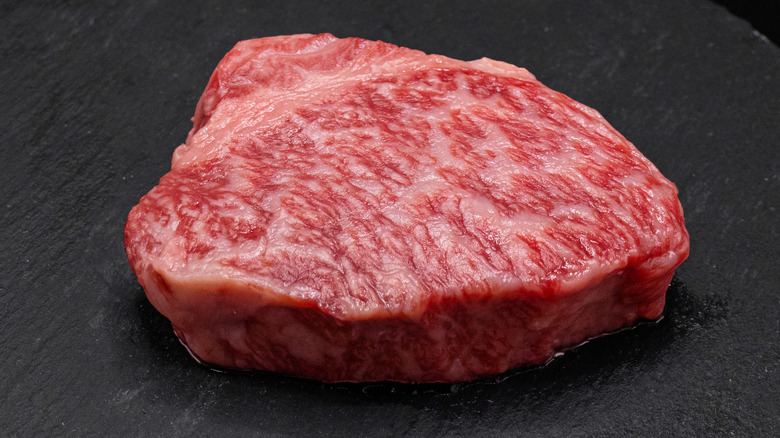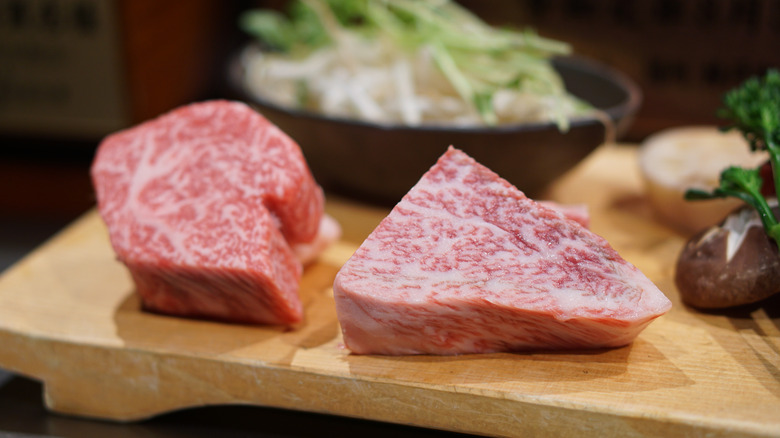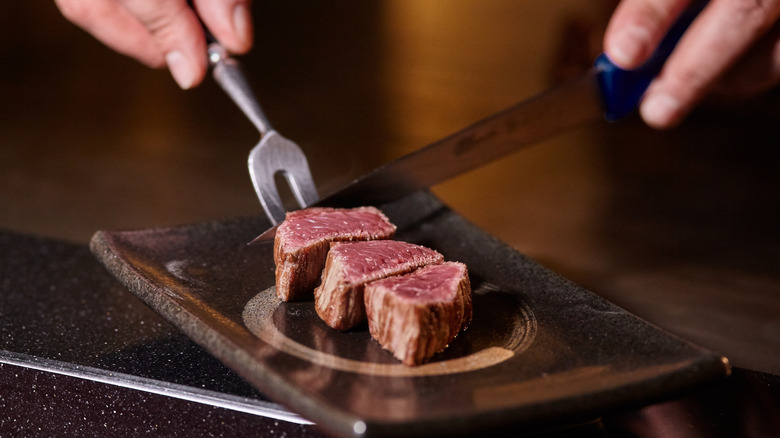Why Kobe Beef Was Once Banned In The United States
Kobe beef is known for being the apex, the pinnacle, and the creme de la creme of red meat, but it is also known for being wildly misunderstood and misinterpreted. How expensive is it? Is it banned or not? Is it real or not? These questions have perplexed many over the years, so let's get to the bottom of at least some of them.
Raising, butchering, and eating Kobe beef is a serious, time-honored tradition, dating as far back as the 1600s in the Hyogo Prefecture in Kobe, Japan, according to Robb Report, and this tradition continues today. Even true Japanese Kobe eaten presently can be traced back to the cattle that was roaming in the 1600s.
Serious Eats notes that the term wagyu can be referring to any of four different Japanese cow breeds. The beef is highly marbled with fat that lends the most amazing flavor to the highly cherished beef. Many say that the uber-fatty beef melts in your mouth and is a luxurious, unctuous flavor.
Some equate the sheer prestige and flavor of Kobe with foie gras, caviar, or the most top-notch wines. That helps explain why, as The Chicago Tribune tells us, kobe beef is a registered trademark in Japan.
Why was Kobe beef banned?
There is a very highly-regarded qualification process that the Japanese government oversees to ensure the absolute most pristine Japanese Kobe. A 2016 Bon Appétit article states that "true Kobe" is sold at only eight restaurants throughout the US — that's how highly prized the beef is.
"Real Kobe beef" strictly comes from Kobe, Japan, so unfortunately, most of the "Kobe" that people are eating in restaurants or at home isn't tried and true Kobe. Of course, as Serious Eats points out, the same thing can be said about champagne vs. sparkling wine. Two especially highly rated varieties are Snow Beef from Hokkaido and a5 Kobe, which is revered worldwide. Perhaps it goes without saying, but Kobe is usually very, very expensive; Serious Eats says that a "true" Kobe A5 ribeye will set you back about $350 for a 14-ounce steak. It is also imperative that if you're shelling out the money for this level of beef, be sure to cook it as properly and correctly as possible.
A little goes a long way
Also bear in mind that with beef this fatty, a little goes a long way.
It was illegal to export Kobe cattle for almost 200 years, according to Free Graze Foods. That changed when two cattle were shipped to America in 1976. Between then and the 2001 US ban, only the most absolutely elite restaurants imported the beef. The US initially banned Kobe beef cattle exporting due to fears of spreading mad cow disease in the early 2000s, and for the next decade, the bans were lifted and reinstated and lifted again, according to NBC News. When it was first banned again after the 2001 ban, many "spinoffs" called American-style or American-brand beef began to pop up, which used meat from cows that were not at all true Kobe, but had a somewhat similar flavor and marbling. On the bright side, they sold much more cheaply and could be produced in the US. Free Graze Foods notes that the USDA does not "permit the use off the term Kobe as an isolated label," which is why these new variations had to be deemed American-style.
The story of the history, bans, and laws is definitely a bit convoluted, but the indulgence of Kobe beef clearly inspires much devotion.


